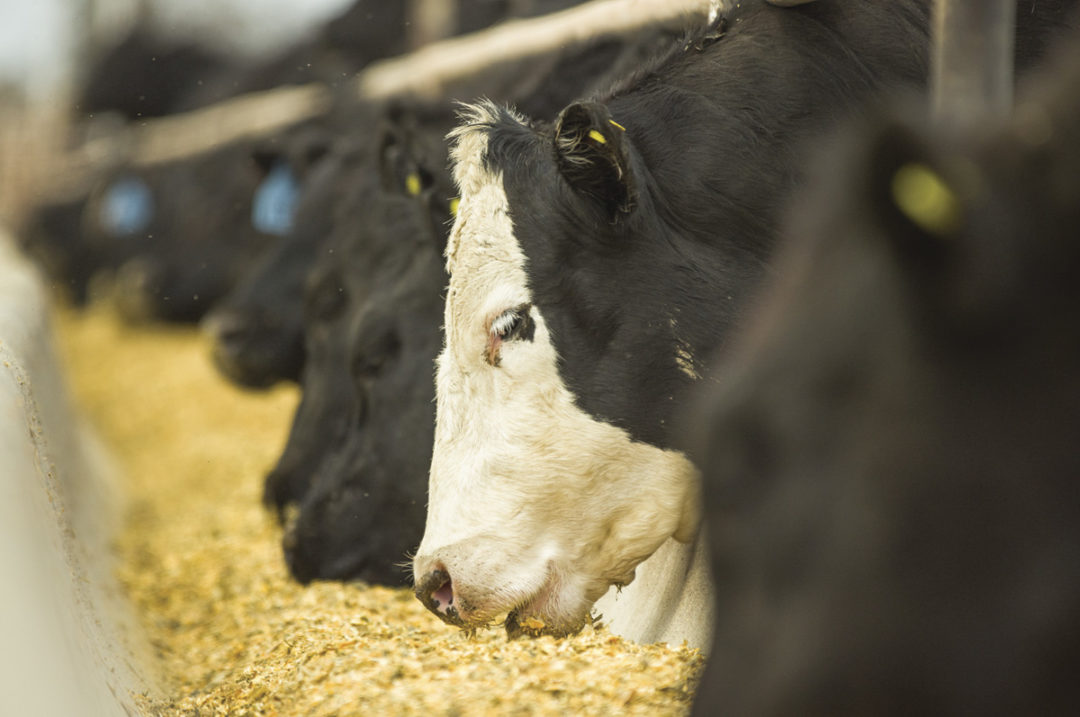Feed efficiency is obviously one of, if not the single most important parameter when it comes to maximizing profitability on any feedlot. Therefore, it’s not surprising that nutritionists and feedyard managers alike are always pushing toward improving feed efficiency, utilizing strict bunk management programs and research-proven feed additives to help accomplish this goal. Over time, the industry has accepted that ionophores, such as monensin, as well other feed-grade antibiotics can often help enhance feed efficiency. However, while conventional feedlot operators have benefited from the use of ionophores in the diet, producers feeding all-natural cattle are generally handcuffed from utilizing ionophores and other antibiotics.
Thankfully, there are other all-natural, science-based solutions that can be used alongside ionophores in conventional programs but also as a go-to solution in all-natural feedlot situations. These postbiotic products work through a different mode of action than ionophores to help ensure optimum rumen health and ration utilization. By incorporating a product like this into your feed, not only can you help your cattle be more efficient, but it could also help to decrease your feed bill and cost of gain.
Feed costs of finishing natural cattle
High corn prices and other feed expenses can create challenges for cattle feeders and the beef industry. Although feed costs may vary from year to year and from region to region, feed still represents the largest single expense within any operation (aside from the purchase price of the animal). In fact, as we can see from Figure 1, corn and other feed ingredient prices have risen dramatically the last two to three years.
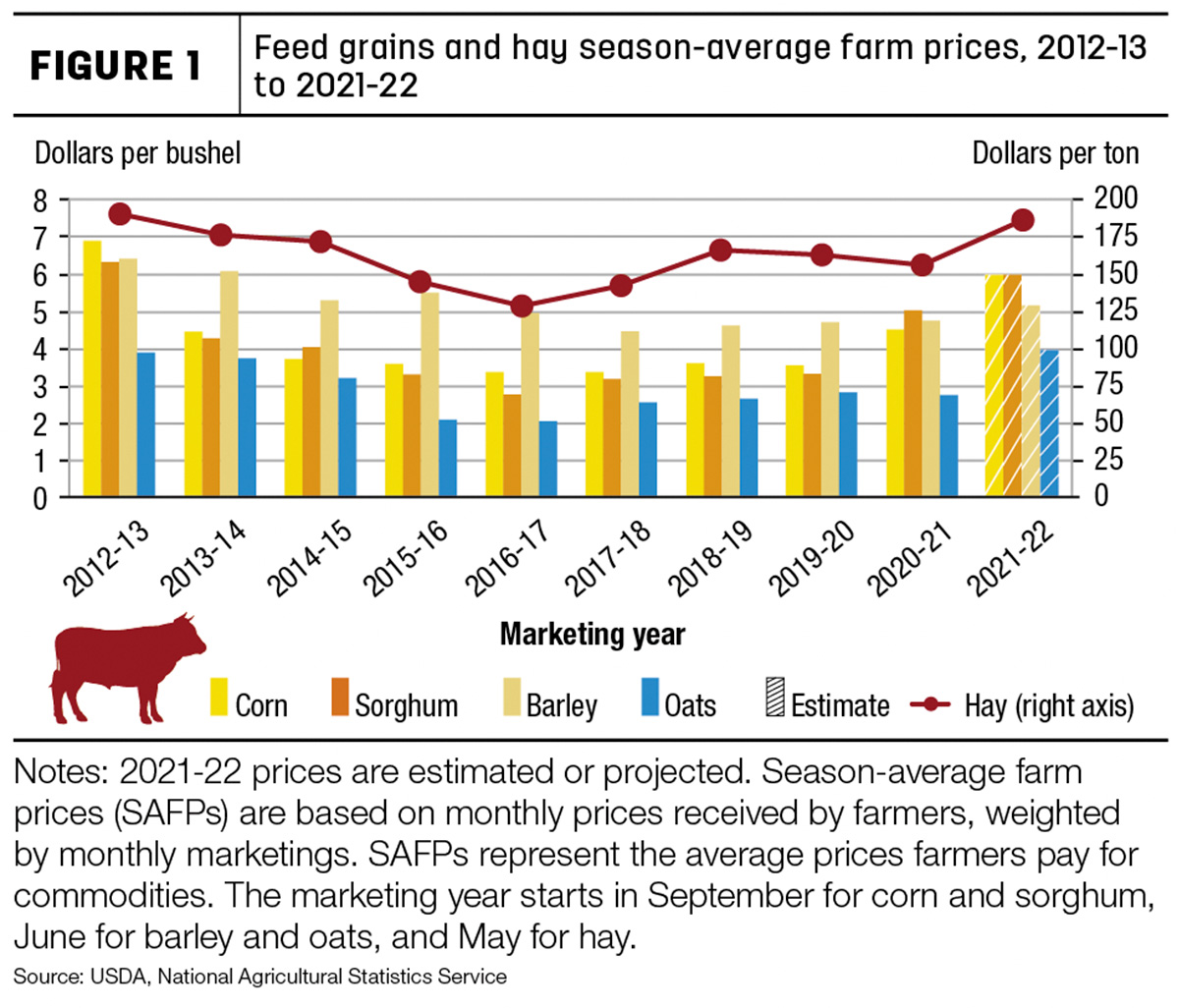
As a result of this, producers must seek solutions to help optimize feed digestibility and utilization, thereby improving their economic return in the long run. Thankfully, there are some science-based solutions to help ensure optimum ration utilization.
Feeding natural cattle takes a unique approach
It’s important to keep the rumen healthy, which translates into better gain and feed efficiency. Within the rumen, there are many species of microorganisms including bacteria, protozoa and fungi. These microorganisms play a key role in optimizing rumen function by producing enzymes that aid in digestion of dietary components, such as fiber and starch. A stable rumen environment is also important for proper digestibility of feed. This includes optimal rumen pH and balance of microorganisms for the diet being fed. A consistent pH above 5.6 within the rumen is a good indicator of a healthy rumen environment. Inadequate fiber in the diet, overprocessed grain and poor bunk management can all lead to acidosis (low rumen pH).
Acidotic conditions such as this can create a cascade of negative events, starting with a shift in the microbial community within the rumen. This may not only cause a decrease in feed digestibility but can also lead to additional problems such as bloat, inconsistent feed intake and liver abscesses (which can also decrease performance). Remember that with natural programs, tools such as ionophores and tylosin are not generally available for us to rely on for bloat control or liver abscess protection. Therefore, rumen health becomes a much greater risk factor that must be controlled.
Improve gut health and strengthen immunity
With fewer feed-additive options to choose from that are cleared for use in natural programs, using an all-natural postbiotic product to help support digestive health and immune strength is foundational to ration utilization. These products work largely by balancing the rumen microbiota and optimizing the rumen environment. A study at the Lethbridge Research and Development Centre in Alberta demonstrated that cattle fed a postbiotic feed additive were able to maintain a more consistent rumen pH over time compared to cattle on control or even monensin plus tylosin treatments. This research indicates that a postbiotic feed additive helps create a healthier, more robust rumen environment that is more resilient, more efficient and less likely to contribute toward costly liver abscesses, as seen in Figure 2.
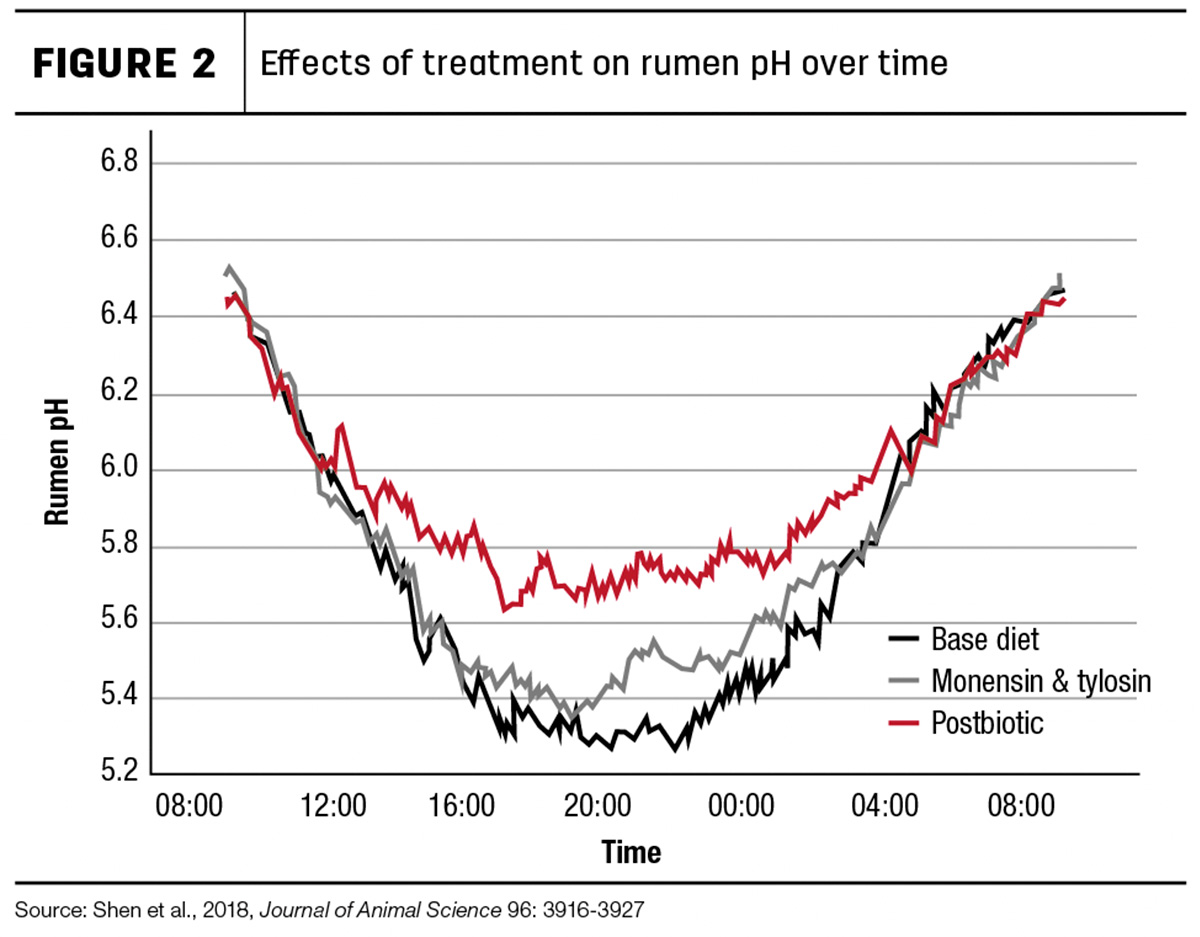
Effects of treatment on rumen pH over time
When an animal’s rumen is functioning optimally, it has the right balance of microbiota (bacteria, protozoa and fungi) in a stable environment to digest feed more efficiently, making more energy, protein and other nutrients available to the animal. This will help improve ration digestibility and optimize gain and feed conversion, resulting in improvements in production and overall health.
Researchers at the Lethbridge Research and Development Centre also compared ration digestibility in steers fed feedlot diets with or without a postbiotic feed additive. The results of this trial not only showed increased rumen pH but also significant (P less than 0.01) increases in ruminal and total tract neutral detergent fiber (NDF) digestibility (28.1% and 20.4%, respectively) as a result of adding a postbiotic feed additive to finishing cattle diets. In addition, ruminal organic matter digestibility increased (P less than 0.03) by 18.1%, while total tract organic matter digestibility tended (P less than 0.07) to be higher as well.
Trust the science and trust the manure
Decades of research and dozens of trials have gone into proving the efficacy of postbiotic products (Figure 3). John Wagner, a professor of feedlot nutrition and management at Colorado State University, conducted a meta-analysis, or statistical summary, of production outcomes across all feedlot trials conducted with one specific family of postbiotic products. His conclusions, across more than 20 trials, showed that not only were postbiotic products able to significantly increase daily gain (up 6.5%, P less than 0.01), but they also improved feed efficiency (up 2.6%, P less than 0.0001). This response is due to improved rumen health and greater utilization of starch and other nutrients in the diet. This is supported by years of producer claims that cattle consuming a postbiotic product seemed to have less corn in their manure.
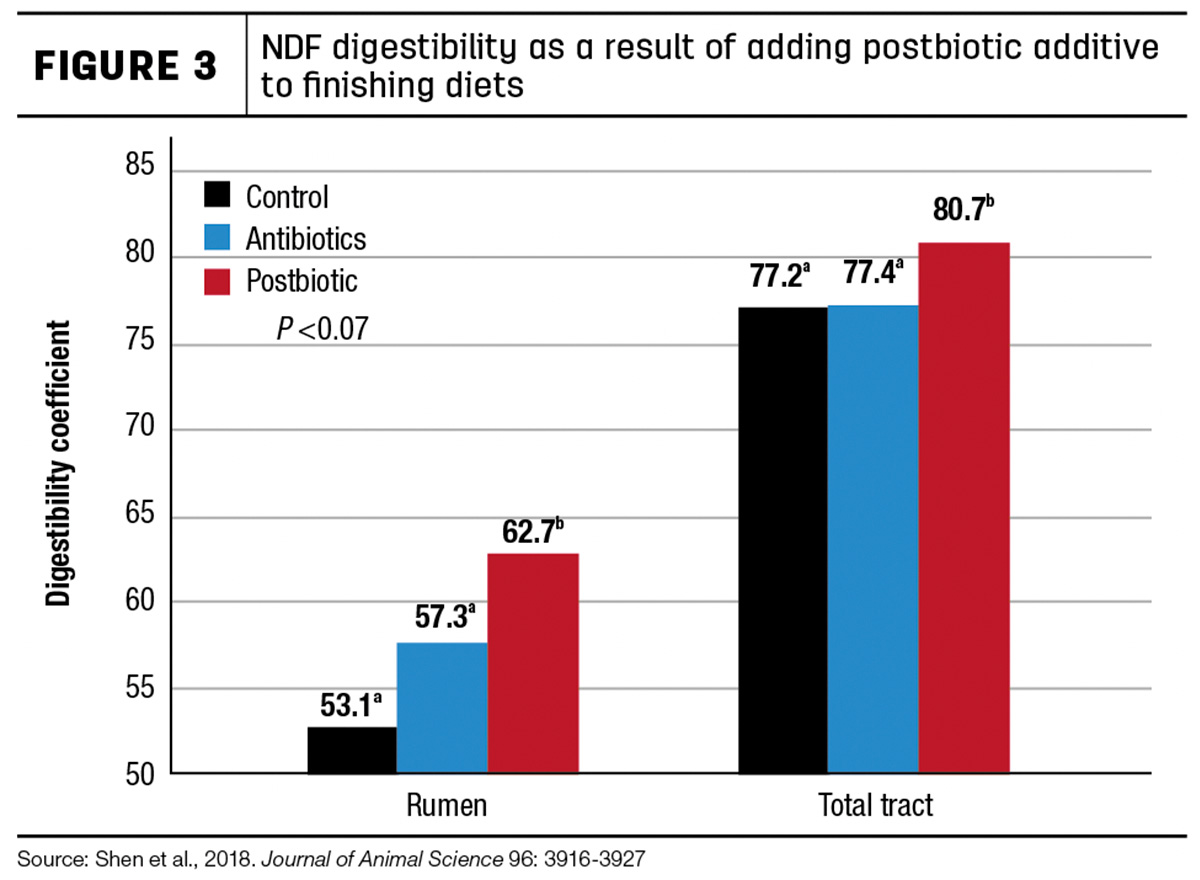
Several years ago, scientists put this claim to the test in a feedlot trial conducted in western Nebraska. In this study, 2,214 steers were allocated across 14 pens, with half of the pens on a control diet and the other half on a postbiotic feed additive. One aspect of this study involved the feedlot veterinarian collecting representative fecal pen floor samples from each pen, pooling the samples, and sending them to the University of Nebraska for analysis. Scientists analyzed the diet as well as fecal samples for percents of nitrogen and starch, and they were able to predict ration starch digestibility using the regression equation presented by Zinn et al. The results of the study showed that cattle on the postbiotic feed treatment had numerically higher predicted starch digestibility, resulting in a 6.2% numerical advantage in feed-to-gain ratio.
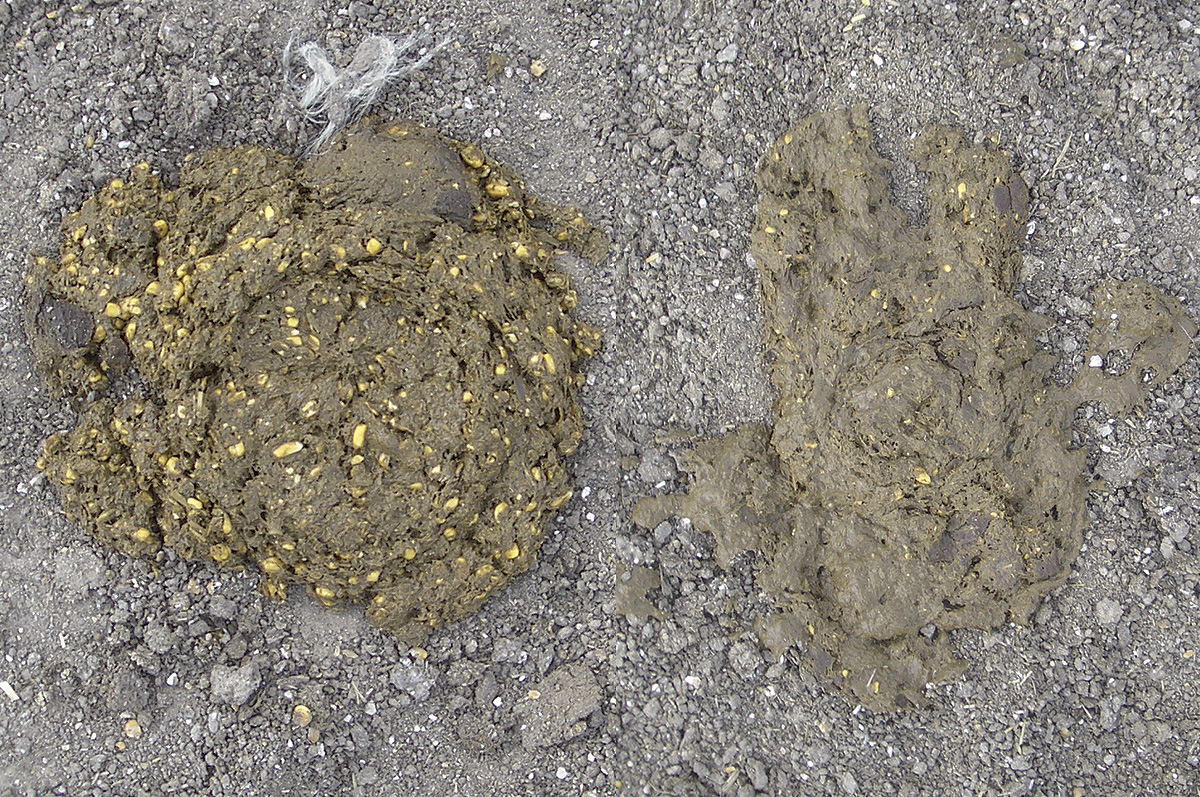 A University of Nebraska study showed that feedlot steers fed with a postbiotic feed additive (right) had higher predicted starch digestibility than those fed a control ration (left), leading to a significant advantage in feed-to-gain ratio. Photos courtesy of Diamond V.
A University of Nebraska study showed that feedlot steers fed with a postbiotic feed additive (right) had higher predicted starch digestibility than those fed a control ration (left), leading to a significant advantage in feed-to-gain ratio. Photos courtesy of Diamond V.Feed efficiency, as measured by feed-to-gain ratio, is perhaps the most telling, real-world number when it comes to assessing feedstuff utilization and applying economics to the decision to include a supplement. Ultimately, we want to get as much out of our feed as possible. With a digestive and immune support product, you can help make this achievable for cattle.
As we look now and into the future, feed costs and optimizing ration utilization will continue to be a top priority in both conventional and natural programs alike. It is important to consider what steps can be taken to help succeed amidst this challenge. By keeping rumen health a priority and utilizing all-natural, research-proven solutions, not only can you help your cattle grow faster, but you can also support enhanced digestibility and feed conversion. This ensures your cattle are getting the most out of their feed, which is especially important during times of elevated feed costs.
References omitted but are available upon request. Click here to email an editor.
